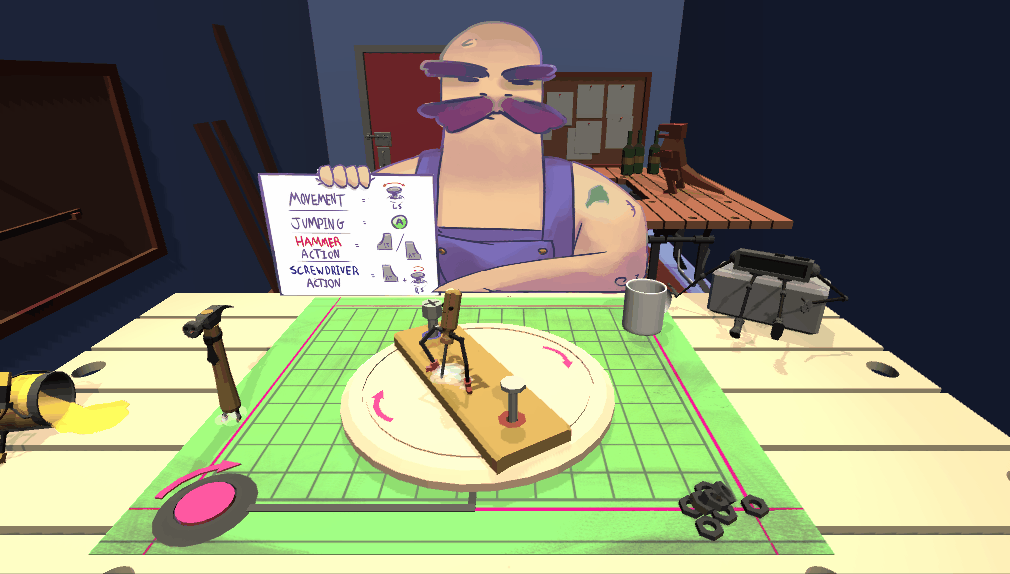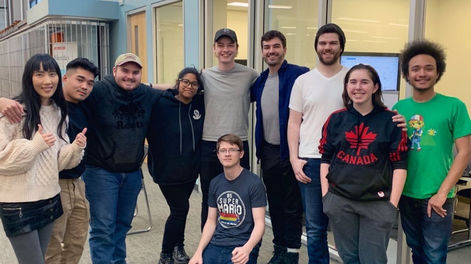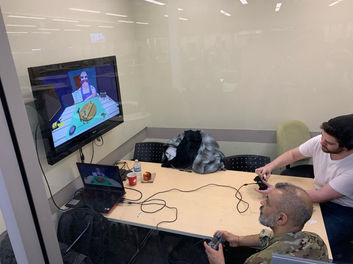
REPAIR
A friendly coop puzzle game to repair toys as tools
Team Size : 10 people
Tools Used : Google Docs, Unity
Role : Project Manager, QA
Time : 48 hours | Jan 2020
Challenge
Global Game Jam is an annual event where participants create a game in 48 hours for the year 2020, the theme revealed was “repair”
Design Goals
Repair: as a large team we needed to collaborate and create a game with an immersive experience while keeping in mind the voices and design goals of 10 different people
Refine: throughout the development of the game it was important to communicate all the tasks and goals to ensure the best player experience and team dynamic
Replay: it was important to have a game with high replayability but a system that can help our team during the development. A proper routine and scope size is necessary especially with our team size and time constraint
Fixing it up
One of our first steps before even starting development is always ideating and brainstorming. Repair is a theme that can be interpreted in many ways. Unfortunately, getting 10 people to work together in a span of 48 hours on one project and have a general consensus on an idea is extremely challenging.
We noted every single idea and added it on the board. Everything was written down even silly concepts such as "Everyone is a tool". From simple to silly ideas we started to narrow it down to players playing as tools and repairing toys.


Ideation and Brainstorming on the white board
After we came up with a concept, we had yet to overcome our biggest challenge. Our team consisted of 10 people, although we had many people and multiple skill sets, it can be a double edge sword. We could divide tasks to multiple people but this easily could become disorganized.
Communication is key
As mentioned prior, our team size can allow each person to be appointed to a specific task. But without proper communication, there can be room for misinterpretation. In order to avoid any confusion and focus on the main goal, constant check ins occurred. Although it was only a 48 hour game jam it was vital to hear from each member. Check ins involved what a member was working on, their progress and their next steps.



Character Tool Design progress
While these check ins occurred, another method to keep track of everyone's progress was screenshots. These screenshots were used for documentation on updates and progress. This also gave us a chance to review for any changes so we could have the best user experience and if everyone was on the same page when it came to project vision.




Puzzle Design progress
Repeating a process and consistency
Repetitive check ins allowed the team to notice anything wrong with the game. This essentially made us constantly aware of all the bugs and any minor adjustments in the game so we could quickly act on these issues. It was a good system and routine to get us to notice tasks that needed to be fixed. Some of these issues included the visual offset when the screwdriver screws a toy. We went through many different iterations and finally resolved the issue of a simple animation state transition conflict. Documenting all the check ins allowed us to review past notes and cuts so we can improve the game if we ever had time to come back to it.


Offset screwdriver issue
Since we documented everything, it was easier to refer to all the issues and observation when people played our game during the end of Global Game Jam. Our team was extremely proud of our game and saw its value so we decided to submit it to several events. The Family Day event hosted by Handeye society enabled us to showcase our game. A lot of preparation came to planning for this event, we needed to adjust a lot of issues but we also needed to focus on the promotional aspects of our game. It was important to know how to get spectators to stop by our booth and test one of our fundamental pillars of replay value.

.jpg)

Preparing our booth and setup
In order to get people to visit our booth, we decided to make buttons. It was also important to decorate our booth and make it enticing. So we created a high score board and noted any time players hit a new high score. This allowed players to come back when they noticed their score no longer was on the board or tempted them to play if they can beat it. We noticed players would come back multiple times to get back on the board. Each time players came back they got significantly better and refined their skills, making it was a lovely experience to see.



Returning players to beat the current high score
Takeaways
I had already participated in a Global Game Jam before so this wasn't new to me, however being in a team of 10 people, now that was a first! During the development stages, I was able to learn how to manage a large team and make a game that a majority of us were proud of. It was received really well during the Sheridan Global Game Jam location and even during the Living Arts Centre event hosted by Handeye Society for Family Day 2020.
The Handeye Society event allowed me to learn how to prepare for a showcase and capture spectators to come visit. We also had the opportunity to showcase our game at TCAF 2020 but unfortunately due to COVID-19, was cancelled and we did not get to showcase then. But overall it was a great experience learning how to showcase a game.






